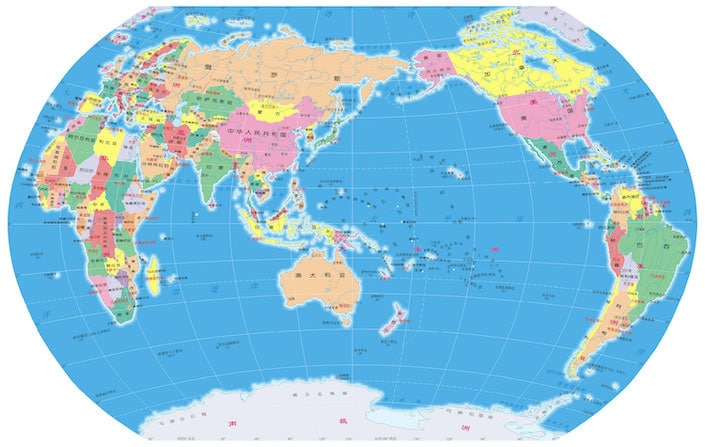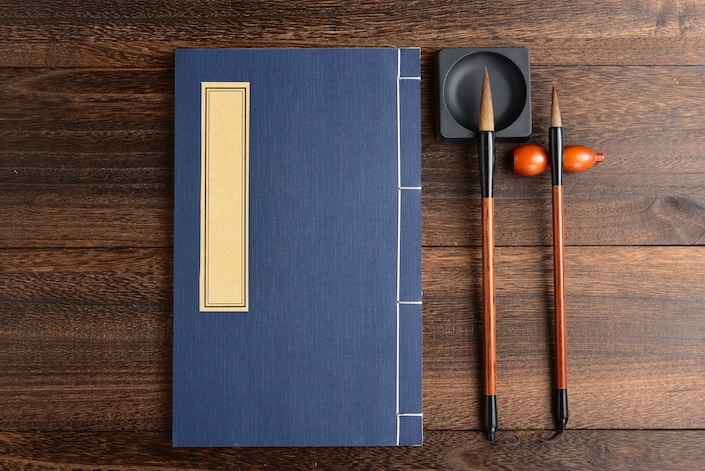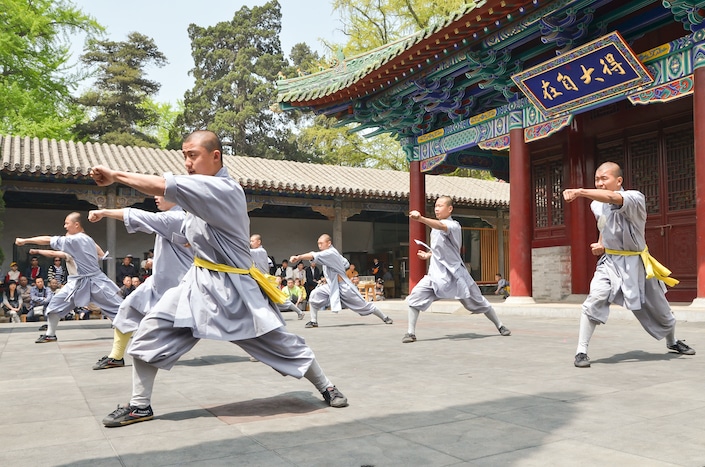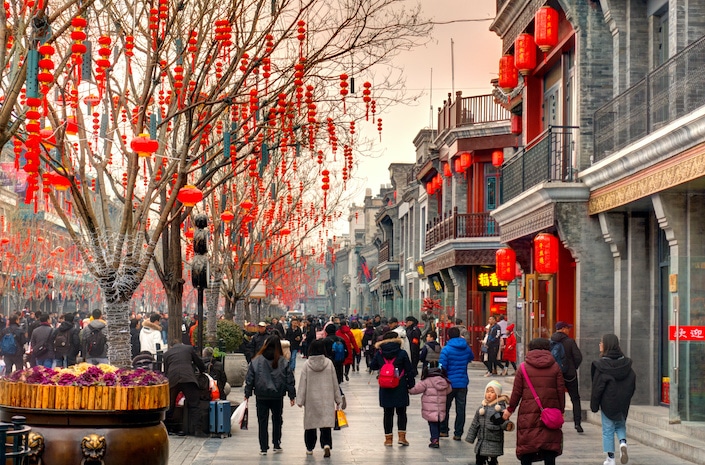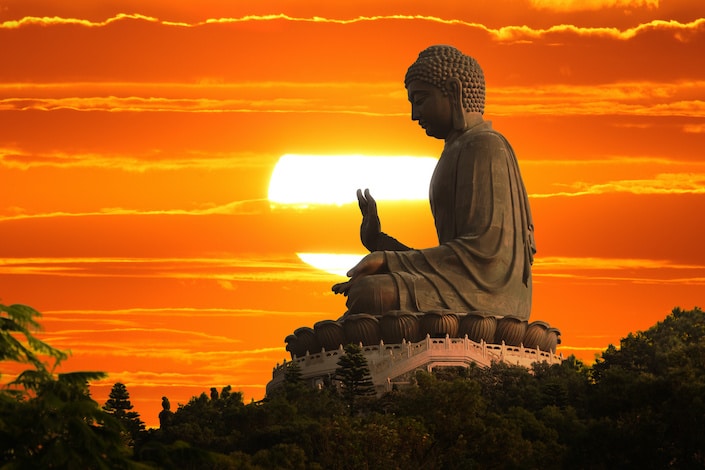What does China's version of the world map look like?
Learn Chinese in China or on Zoom and gain fluency in Chinese!
Join CLI and learn Chinese with your personal team of Mandarin teachers online or in person at the CLI Center in Guilin, China.
It’s in the name! The Chinese word for China fuses two characters, 中 (zhōng) meaning middle or central, and 国 (guó) meaning kingdom or country. Together, these characters form 中国: Middle Kingdom. China’s maps and, arguably, much of its sense of its history and its place in the world can be deduced from these two characters.
Table of Contents
The center of the universe
The map common in classrooms throughout the West is known as the “Mercator projection” and centers the world on Europe/Africa with Asia off to the east and North and South America over on the West.
To those accustomed to this perspective, the experience of first encountering an authentically Chinese map can be a jarring experience. Europe has been shifted to the margins! China now commands the privileged spot, that is, close to the center.
The West and the rest
Beneath this simple shift of longitude and latitude lies a deeper adjustment in perspective.
Since the dawn of European (and, subsequently, American) global hegemony, inhabitants of western countries have largely been taught to see themselves as being at the center of world history. This version of history permeated everything, including geography and, subsequently, cartography.
In this vision of the world the West is the soloist, while the rest are just backup singers.
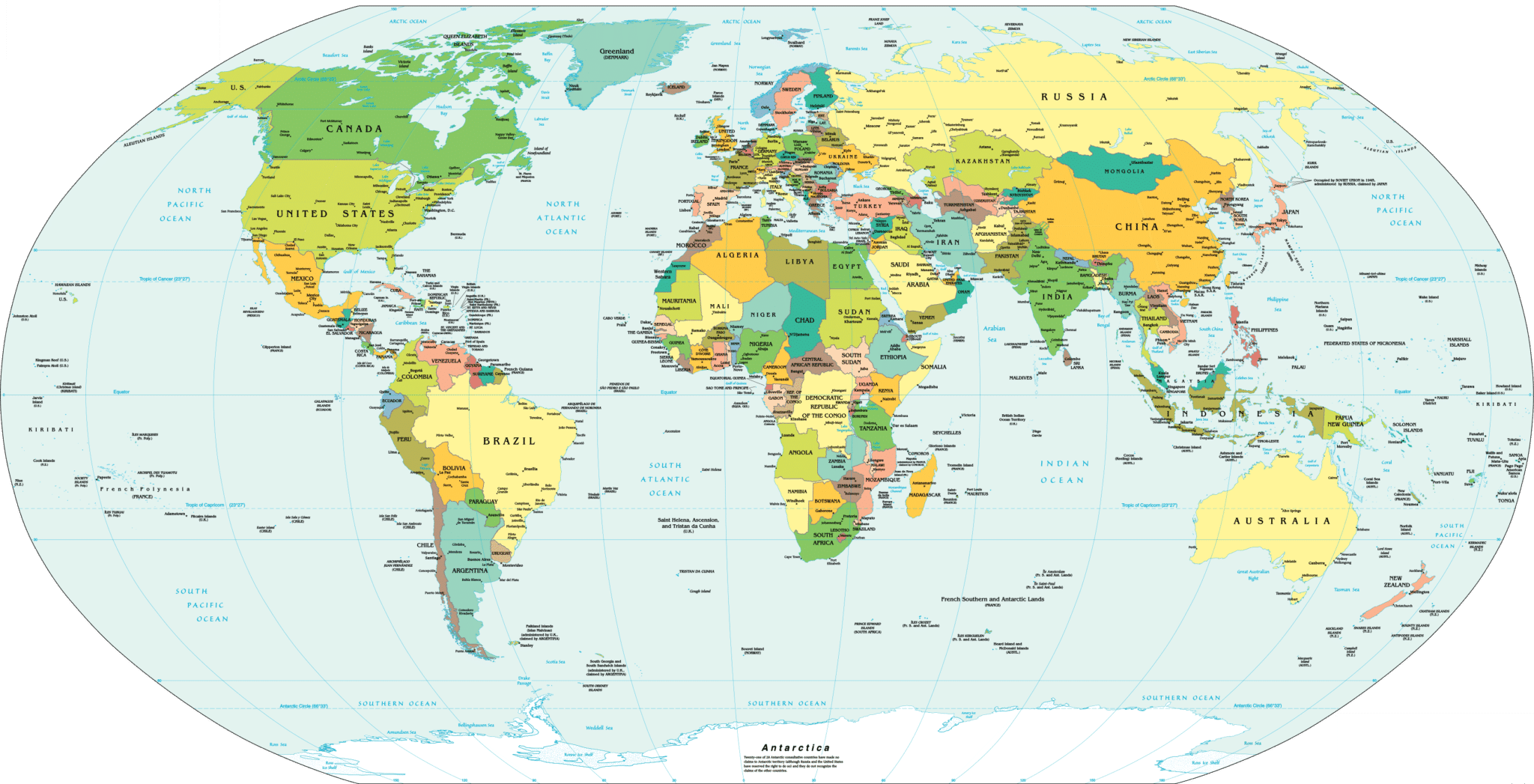
European and American maps of the world, like this one, tend to place Europe and Africa in the center, with the Americas on the left and Asia and China on the right. Click to view high-resolution image.
History doesn't repeat itself, but it often rhymes
China, on the other hand, has a very different understanding of history. The version told in Chinese schools focuses on the many thousands of years during which China was at the civilizational forefront of humankind’s journey, a time during which Western Europe was a relatively unimportant peninsular outcropping.
Paper, gunpowder, the compass, movable type and the printing press—these are some of the oft-repeated fruits of China’s 5,000 years of recorded history.
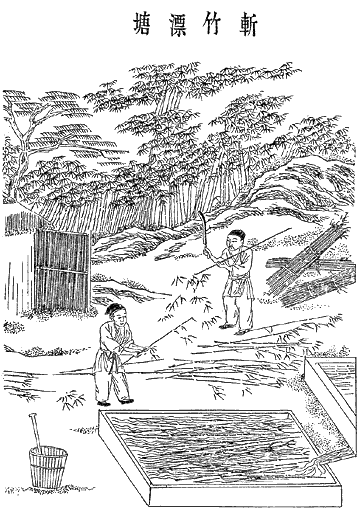
The five major steps in paper making, a process invented in China, were outlined by Cai Lun in 105 CE.
The Kūnyú Wànguó Quántú (坤舆万国全图), the earliest known Chinese world map printed in European style, is an excellent example of this shift in perspective. Drafted in 1602 by Matteo Ricci, a Jesuit missionary, it molds itself to Chinese expectations by showing the Middle Kingdom close to the...well, middle.
In short, the Chinese map reflects the Chinese reality. China is placed near the center of the map because, much like the characters that compose the country’s name, China is near the center of China’s version of history!
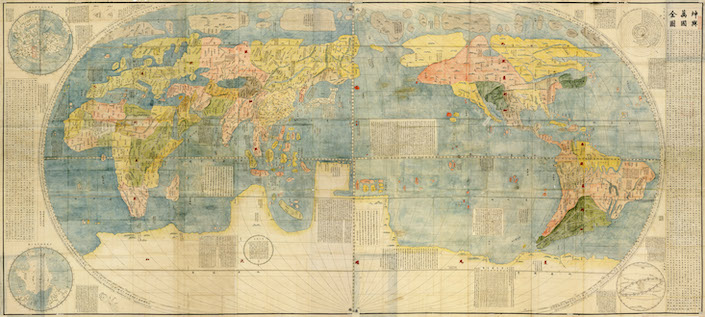
Matteo Ricci’s Kunyu Wanguo Quantu is the earliest known European-style map of China. Click to view high-resolution image.
Ahoy there!
China’s intimate experience with colonialism, imperial collapse (and subsequent loss of territory), and its numerous border disputes with its neighbors have made the government of the People’s Republic of China (PRC) quite sensitive to matters relating to territorial integrity.
This focus transfers over to modern Chinese cartography. The most important of these sensitivities are addressed below.
South China Sea
The hefty controversies surrounding who owns what in the South China Sea (南中国海 Nán Zhōngguó Hǎi) have an outsized influence on the appearance of modern Chinese maps. If the map you’re looking at is a made-in-China ‘real McCoy,’ it will undoubtedly include China’s marine claims to the South China Sea.
However, China is not alone in its claims. The Pacific Ocean is a rough-and-tumble neighborhood and everyone wants in on the action. China is joined by a whole gaggle of other Asian countries (Brunei, Philippines, Malaysia, Vietnam, and Indonesia, to name a few) in contesting bits and pieces of the South China Sea.
China’s territorial claims are usually geographically indicated on maps using what is called the ‘nine-dash line’ (九段线 jiǔduàn xiàn).
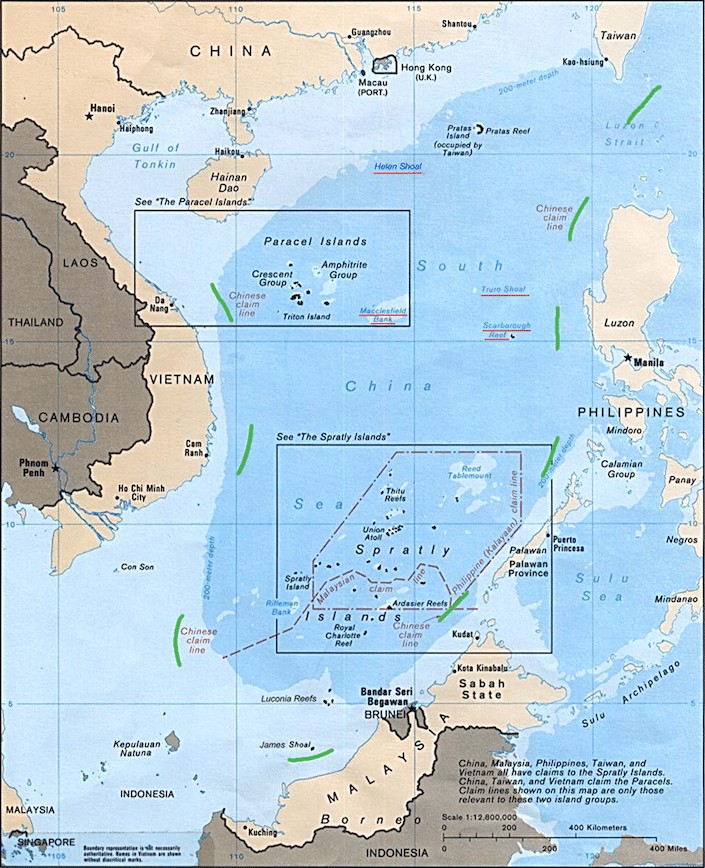
The nine-dash line is an important feature of modern Chinese maps.
It’s serious business out there: Beijing has frequently sent naval vessels to face off against intruders on what it considers its territory. China has also poured thousands of tons of sand into the ocean to create artificial islands to be used for its own sovereign purposes.
China isn’t the only country willing to go to great lengths to defend its claims, however. Various countries including the Philippines and Vietnam have been known to aggressively defend their turf, even going so far as to attack and kill fishermen encroaching on what they consider their marine territory.
On top of this already-flammable situation one can add another explosive element: pirates. The region is rife with pirate organizations, some of which are connected to rebel groups and terrorist organizations equally active in the area.
This tumultuous and complex mix of variables doesn’t change the fact that China continues to consider the South China Sea a carefully guarded piece of China and an essential component of Chinese maps of China.
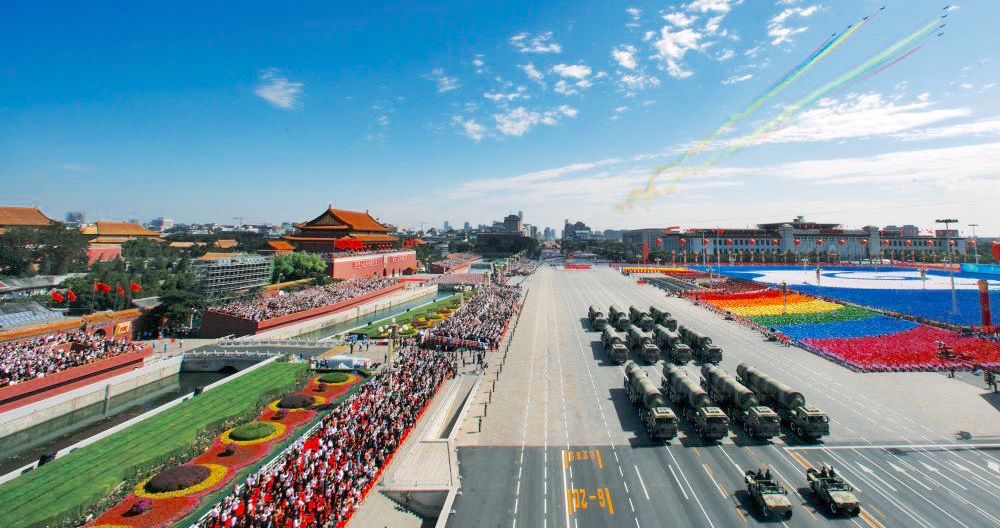
China takes its territorial claims in the South China Sea very seriously.
This land is my land, this land is your land
Two other points of geographical contention that help shape modern Chinese world maps are the Senkaku/Diaoyu Islands.
Known as the Senkaku Islands in Japan and the Diaoyu Islands (钓鱼岛 Diàoyúdǎo) in China, these uninhabited (this characterization is also disputed) islands have been a source of strain in the China-Japan relationship for more than one hundred years. The fact that there is not even a basic agreement about the name hints at how deep the struggle goes.
The vivid memories of many Chinese regarding the actions of Japan during the Second World War, as well as the discovery of undersea oil reserves in the area in the 1960s, have only served to oxygenate this geopolitical fire. A potentially lethal, high-speed game of “cat-and-mouse” between Japanese coast guard and Chinese fishing vessels has become increasingly common.
Consequently, modern Chinese world maps also include the Senkaku/Diaoyu Islands as part of China’s integral territory.
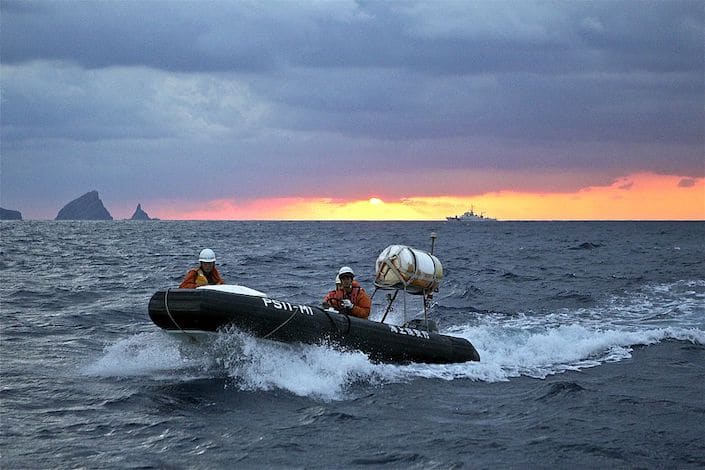
The Senkaku/Diaoyu Islands also appear as part of China on Chinese maps of the region.
The hills are alive
The mountainous Sino-Indian border is another area where there may be some substantial differences between the average Chinese world map and those used in various other countries.
Although the border between the two Asian giants has numerous points of conflict, the two major ones are centered around Arunachal Pradesh (阿鲁纳恰尔邦 Āǔnàqià Ěrbāng) and Aksai Chin (阿克赛钦 Ākèsài Qīn).
2020 saw this frozen conflict go molten hot for a frightening couple of days. In June of 2020, an undisclosed number of Chinese and Indian soldiers were killed and injured in hand-to-hand brawls as border patrols from the two countries clashed with each other in a disputed corner of the Himalayas.
Google Maps, along with National Geographic and many other international mapmaking organizations, have opted to split the difference and extend “dashed lines” across both of these contested territories. These lines represent the claimed boundary and the boundary as it is currently administered.
Naturally, maps produced in China show unchallenged control.
X doesn’t really mark the spot
One of the last features to consider when trying to get a handle on the Chinese cartographic situation is the accuracy (or inaccuracy) of GPS. When browsing a map of China on GPS-powered applications like Google Maps be forewarned: it might not be as precise as could be hoped.
Get off my lawn!
Since the passage in 2002 of the Surveying and Mapping Law of the People's Republic of China, it has been illegal for foreigners—as well as any unregistered entity—to privately gather GPS data in China.
Individuals or groups who break the law could be fined up to 1 million yuan (around $150,000 USD). According to the law, these data collection regulations are an attempt to ensure that the location and GPS data gathered does not “touch upon state secrets or endanger state security.”
Nor is this just an idle legal threat. In 2009, the PRC government charged a group of UK geology graduate students who were working in China for “illegal map-making,” issuing substantial fines. In 2014, Coca-Cola was formally charged as having "illegally collected classified information with handheld GPS equipment" in Yunnan province.
Dozens of such cases have proliferated since the passage of the law.
Enter the matrix: WGS-84 vs. GCJ-02
The string of incomprehensible letters and numbers in the above heading are the two ways that the world processes location data relayed to us by the satellites orbiting our planet. China uses the one on the right (GCJ-02) and most of the rest of the world uses the one on the left (WGS-84).
And this, as Robert Frost reminds us, “has made all the difference.”
Essentially, the uniquely Chinese way of communicating coordinate data to and from satellites is fundamentally different from the rest of the world. When traveling via the Chinese process, before reaching your phone, the coordinates are first fed through an algorithm that purposefully fudges the distances between different spots, slightly diminishing their accuracy.
All locations on the map are tugged slightly in random directions which makes exact coordinates impossible. Although the algorithmic fudging of each coordinate is only plus-or-minus 1 meter, the locations are tugged randomly in different directions, collectively resulting in a lot of distortion. This makes it impossible to reconfigure the accurate coordinates.
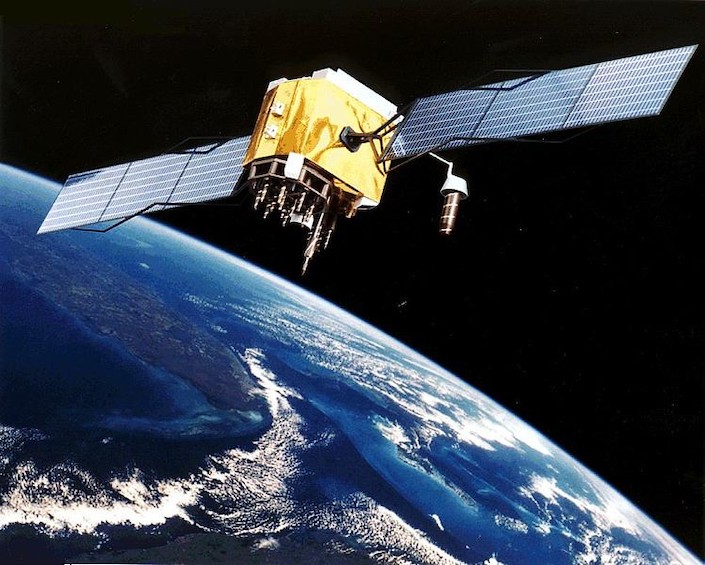
China uses a special algorithm to slightly distort satellite data used to make maps of the country.
Hi, this is your Uber driver
The cybersecurity laws and the unique satellite relaying system have affected the accuracy of Chinese maps and have also caused challenges for ride-hailing and bike-sharing apps that rely on accurate coordinates.
The freely available, crowd-sourced coordinate data used by many smartphone applications simply doesn’t work in the PRC. Only map-making organizations registered with the Chinese government have access to accurate data. Foreign firms must collaborate with one of these organizations to get their apps off the ground.

Ride-hailing apps operating in China must get accurate geographic coordinates from official map-making organizations registered with the Chinese government.
Rooster
For having stuck with us to the end of this wild cartographic journey, here’s a bonus map fact:
China’s map is shaped like a rooster (公鸡 gōngjī).
Despite the surprise and disbelief this may at first elicit, it’s common knowledge and a regularly discussed fact among in-the-know Chinese citizens and China watchers. Take a gander at a map of the country and you’ll quickly see the resemblance.
However, that’s where the agreement stops. Exactly where the head is… now that is up for debate:

It’s often said that China is shaped like a rooster.
Welcome!
Instead of reading about the distorted maps of China, come and get lost in person! Consider arranging a visit to CLI. An educational stay at CLI will provide you a once-in-a-lifetime chance to enjoy cultural, cartographic, and linguistic immersion. And don’t worry, we’ll provide you with accurate directions to help you find the CLI Center with ease.
We look forward to welcoming you to Guilin!
Chinese map vocabulary
| Hànzì | Pīnyīn | Definition |
|---|---|---|
| 中 | zhōng | middle; central |
| 国 | guó | country; kingdom |
| 中国 | Zhōngguó | China |
| 坤舆万国全图 | Kūnyú Wànguó Quántú | "A Map of the Myriad Countries of the World," name of an early western-style map of China |
| 钓鱼岛 | Diàoyúdǎo | Diaoyu Islands |
| 九段线 | jiǔduàn xiàn | the nine-dash line |
| 阿鲁纳恰尔邦 | Ālǔnàqià Ěrbāng | Arunachal Pradesh |
| 阿克赛钦 | Ākèsài Qīn | Aksai Chin |
| 南中国海 | Nán Zhōngguó Hǎi | South China Sea |
| 公鸡 | gōngjī | rooster |


